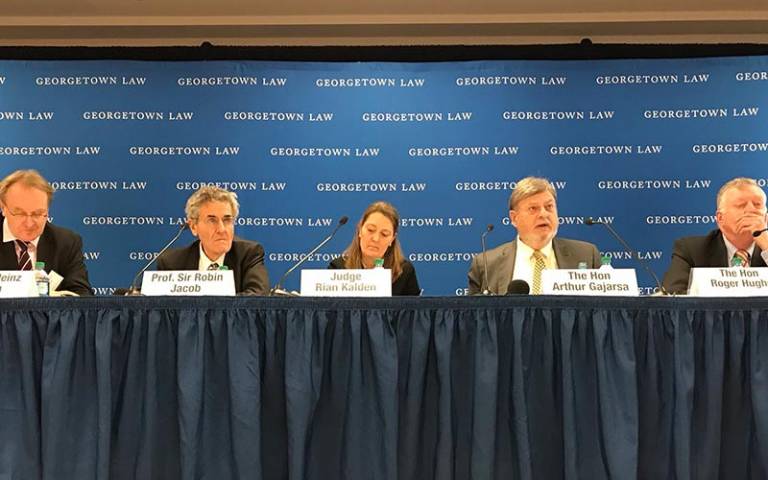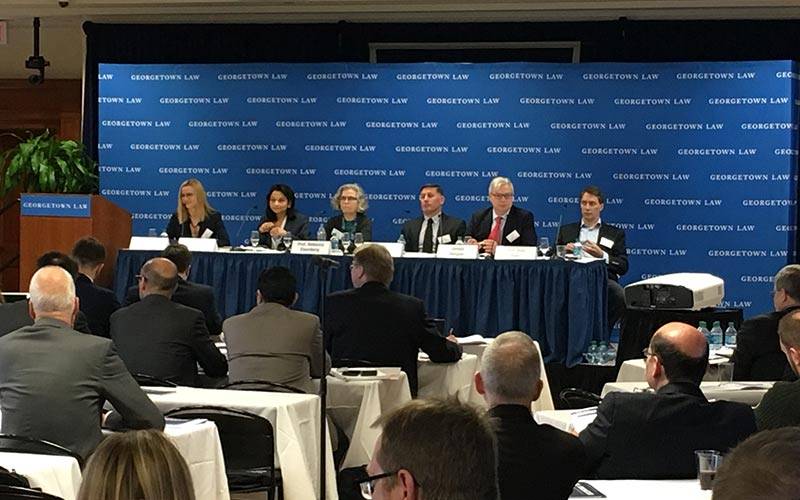Professor Sir Robin Jacob co-hosts the Clinical Innovation conference in Washington DC
20 February 2018

Earlier in the month, UCL Institute of Brand and Innovation Law (IBIL) and Georgetown University Law Center, brought together an unrivalled panel of international judges, academics, scientists, industry experts and regulators to discuss the subject of ‘Fair and Effective Incentives for New Uses of Established Drugs’ in Washington DC.
In 16 sessions, spread over two days, Professor Sir Robin Jacob, Sir Hugh Laddie Chair of Intellectual Property Law at UCL Faculty of Laws, and Professor Jay Thomas, Professor of Law at Georgetown University, co-chaired contributions from 55 presenters and 14 moderators, including Sir Alex Breckenridge, former Chair of the Medicines and Healthcare Products Regulatory Agency and Dr Amitava Banerjee of the UCL Farr Institute of Health Informatics.
New medicines are required to undergo an expensive and time-consuming testing process to gain regulatory approval for a specific disease or condition. The whole process is commercially risky. Approval far from guaranteed, some approved drugs are commercial failures, and others must be withdrawn because of later-discovered side effects leading to costly product liabilities.
The patent system goes some way to supports the immense investment needed by pharma companies. Patent laws allow the patenting of new medicines, and the ‘monopoly’ period of protection provides an opportunity to recoup a return.

Evidence suggests that if only the necessary development work were undertaken, many existing medicines could provide effective treatments for other diseases or conditions. However, the patent system works less well for potential new applications of medicines, which have secured regulatory approval, but for another disease.
Typically, by this stage, the medicine is already on the market and patent protection may have expired, or nearly so. Once a medicine is open to generic competition, prices fall and it no longer commands the price premium which justifies the investment into researching any new use – so no one does.
Although some jurisdictions do provide for some patent protection for subsequent medical uses, patent applications may still fail because the second use is not novel or inventive, and there are obvious practical difficulties in having the same medicine on the market at a low price for the ‘old’ (patent expired) use while at a higher price for the new use. It is also difficult to police whether a cheaper generic product is being used for the ‘old’ or the ‘new’ indication.
The conference sought to establish the actual size of the problem: how many opportunities for potential new uses are not being followed up? It also considered new ways to incentivise the much-needed research into new uses for known medicines. If solved, this problem would be a huge benefit to humankind, since better treatments for a wider range of diseases and conditions would be obtained at a much lower cost than the price of a wholly new medicine, and with far less regulatory delay.
Speaking after the conference, Sir Robin was optimistic:
'This is, we hope, the beginning. If policy-makers, politicians and payors could understand that they can get what are, clinically speaking, new medicines for around a quarter to a third of the cost of a new molecule new medicine, they would jump at it. The problem is getting people to understand. We will find a way.'
It is intended that the papers from the conference will be published as a collection later in 2018.
Pharma repurposing: old drugs, new tricks, Managing Intellectual Property (login required)
Repurposing existing drugs for new indications, The Scientists
 Close
Close

